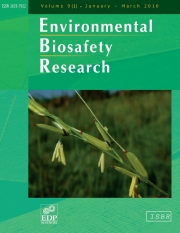Crossref Citations
This article has been cited by the following publications. This list is generated based on data provided by
Crossref.
2006.
Clarifications of the Scientific Panel on Genetically Modified Organisms following a request from the Commission related to the opinions on insect resistant genetically modified Bt111 (Reference C/F/96/05.10) and 15072 (Reference C/ES/01/01) maize.
EFSA Journal,
Vol. 4,
Issue. 11,
2006.
Opinion of the Scientific Panel on genetically modified organisms [GMO] on the Post Market Environmental Monitoring (PMEM) of genetically modified plants.
EFSA Journal,
Vol. 4,
Issue. 3,
p.
319.
Devos, Yann
Reheul, Dirk
De Waele, Danny
and
Van Speybroeck, Linda
2006.
The interplay between societal concerns and the regulatory frame on GM crops in the European Union.
Environmental Biosafety Research,
Vol. 5,
Issue. 3,
p.
127.
2006.
Guidance document for the risk assessment of genetically modified plants and derived food and feed by the Scientific Panel on Genetically Modified Organisms (GMO) ‐ including draft document updated in 2008.
EFSA Journal,
Vol. 4,
Issue. 4,
Matten, Sharlene R.
Head, Graham P.
and
Quemada, Hector D.
2008.
Integration of Insect-Resistant Genetically Modified Crops within IPM Programs.
p.
27.
Züghart, Wiebke
Benzler, Armin
Berhorn, Frank
Sukopp, Ulrich
and
Graef, Frieder
2008.
Determining indicators, methods and sites for monitoring potential adverse effects of genetically modified plants to the environment: the legal and conceptional framework for implementation.
Euphytica,
Vol. 164,
Issue. 3,
p.
845.
Schmidt, Kerstin
Wilhelm, Ralf
Schmidtke, Jörg
Beißner, Lutz
Mönkemeyer, Wenke
Böttinger, Petra
Sweet, Jeremy
and
Schiemann, Joachim
2008.
Farm questionnaires for monitoring genetically modified crops: a case study using GM maize.
Environmental Biosafety Research,
Vol. 7,
Issue. 3,
p.
163.
Wilhelm, Ralf
Sanvido, Olivier
Castanera, Pedro
Schmidt, Kerstin
and
Schiemann, Joachim
2009.
Monitoring the commercial cultivation ofBtmaize in Europe – conclusions and recommendations for future monitoring practice.
Environmental Biosafety Research,
Vol. 8,
Issue. 4,
p.
219.
Devos, Yann
De Schrijver, Adinda
and
Reheul, Dirk
2009.
Quantifying the introgressive hybridisation propensity between transgenic oilseed rape and its wild/weedy relatives.
Environmental Monitoring and Assessment,
Vol. 149,
Issue. 1-4,
p.
303.
Aviron, S.
Sanvido, O.
Romeis, J.
Herzog, F.
and
Bigler, F.
2009.
Case-specific monitoring of butterflies to determine potential effects of transgenic Bt-maize in Switzerland.
Agriculture, Ecosystems & Environment,
Vol. 131,
Issue. 3-4,
p.
137.
2009.
Scientific report of EFSA prepared by the GMO Unit on Public Consultation on the Updated Guidance Document of the Scientific Panel on Genetically Modified Organisms (GMO) for the risk assessment of genetically modified plants and derived food and feed.
EFSA Journal,
Vol. 7,
Issue. 5,
p.
293r.
Sanvido, O.
Romeis, J.
and
Bigler, F.
2009.
An approach for post‐market monitoring of potential environmental effects of Bt‐maize expressing Cry1Ab on natural enemies.
Journal of Applied Entomology,
Vol. 133,
Issue. 4,
p.
236.
Rauschen, Stefan
Schultheis, Eva
Hunfeld, Heinz
Schaarschmidt, Frank
Schuphan, Ingolf
and
Eber, Sabine
2010.
Diabrotica-resistantBt-maize DKc5143 event MON88017 has no impact on the field densities of the leafhopperZyginidia scutellaris.
Environmental Biosafety Research,
Vol. 9,
Issue. 2,
p.
87.
2010.
Guidance on the environmental risk assessment of genetically modified plants.
EFSA Journal,
Vol. 8,
Issue. 11,
p.
1879.
Myhr, Anne Ingeborg
2010.
A Precautionary Approach to Genetically Modified Organisms: Challenges and Implications for Policy and Science.
Journal of Agricultural and Environmental Ethics,
Vol. 23,
Issue. 6,
p.
501.
Bartsch, Detlef
Devos, Yann
Hails, Rosie
Kiss, Jozsef
Krogh, Paul Henning
Mestdagh, Sylvie
Nuti, Marco
Sessitsch, Angela
Sweet, Jeremy
and
Gathmann, Achim
2010.
Genetic Modification of Plants.
Vol. 64,
Issue. ,
p.
575.
Devos, Yann
Lheureux, Karine
and
Schiemann, Joachim
2010.
Genetic Modification of Plants.
Vol. 64,
Issue. ,
p.
553.
Beckie, Hugh J.
Hall, Linda M.
Simard, Marie‐Josée
Leeson, Julia Y.
and
Willenborg, Christian J.
2010.
A Framework for Postrelease Environmental Monitoring of Second‐generation Crops with Novel Traits.
Crop Science,
Vol. 50,
Issue. 5,
p.
1587.
Collier, Marcus J.
and
Mullins, Ewen
2010.
The CINMa Index: Assessing the potential impact of GM crop management across a heterogeneous landscape.
Environmental Biosafety Research,
Vol. 9,
Issue. 3,
p.
135.
2011.
Scientific Opinion on application (EFSA-GMO-UK-2008-60) for placing on the market of genetically modified herbicide tolerant maize GA21 for food and feed uses, import, processing and cultivation under Regulation (EC) No 1829/2003 from Syngenta Seeds.
EFSA Journal,
Vol. 9,
Issue. 12,
p.
2480.

